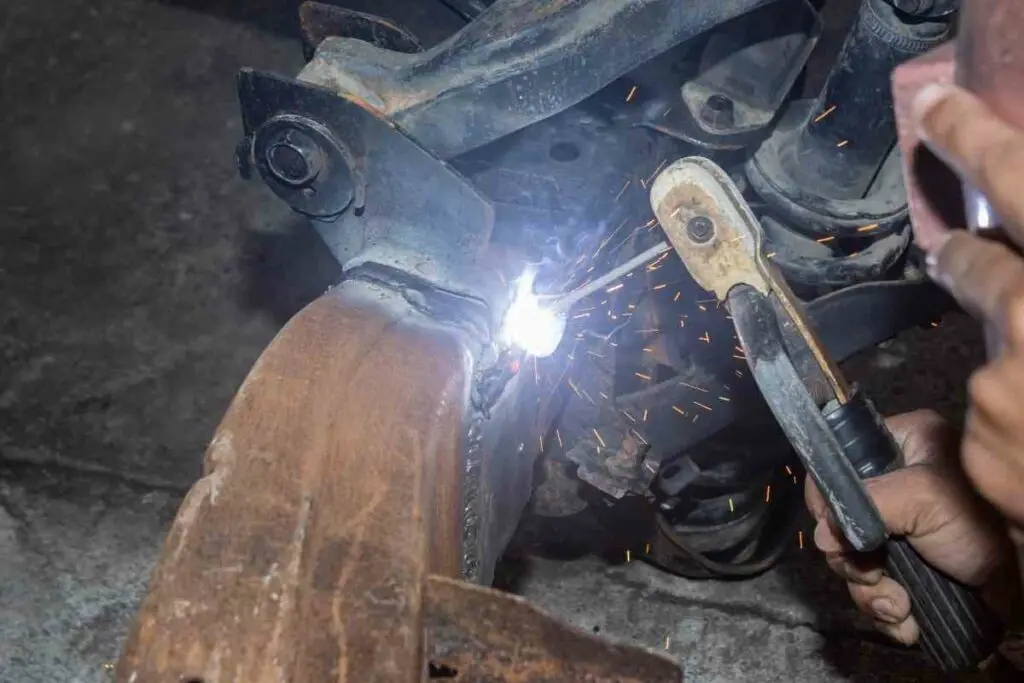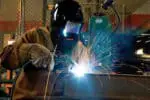Car frame welding is not an easy task. When it needs to be done, there are a lot of factors that make the process quite complicated. Apart from skills and the right equipment, you need to know the right method to weld a car frame before executing it.
Among the most used welding methods, both MIG and TIG are the most preferred techniques for working on car frames. Yet, the former is always given an upper hand over the latter for very specific reasons including ease of working and less time needed to finish the work.
To know which method to use when a person first needs to understand all about car frame welding.
How Does MIG Become A Better Option Than TIG To Weld Car Frames?
If you search for the best welding method for car frames, the majority of the articles will tell you that it is MIG. The technique sure has a lot of advantages to it.
When it comes to welding an important part like a car frame, these advantages become even more prominent. Let’s see what they are:
1.) Less Complicated: MIG by itself is not that easy welding method, yet when compared to TIG, the technique makes it a lot easier for the welder to start the process.
While for TIG the filler metal is added manually, here it is taken care of by the machine and the settings that are set before the process is started. A trouble-free starting is ensured with MIG which is not the case with TIG.
2.) Suitable For Alterations And Changes: A MIG machine is known for its efficiency in making alterations to finished car frames. If the machine is suitable for the metal used, then it is recommended not to go for other methods and work on the metal at one go.
As alterations are just small works that need a quick fix, MIG becomes the apt choice. The ease with which the work gets done makes the process enjoyable.
3.) The Quickest Way To Go: Experts opine that the technique is mainly adopted to weld car frames as they want it to get done faster.
As the process is less complex and mostly under the control of the machine, it does not take months to finish the work unlike with other methods.
4.) Best For Tackling Thick Metals: MIG is known for its quality to penetrate thick metals. This makes it best for dealing with a car frame that is specially made with metal that is strong enough to give substantial support to the automobile.
All this said, there are certain disadvantages to this method that you need to know.
5.) Can Be A Messy Process: Molten metal sputtering is a huge turn-off for MIG. In car frame welding, however, proper post-welding cleaning is anyway recommended, due to the big parts and the requirement of a smooth weld texture.
6.) Do Not Work Well With Aluminum: Yes, MIG welding aluminum for car frames is never a good pick. Unlike other metals, the heat created by MIG machines cannot be tolerated by aluminum.
It can lead to over-penetration thereby ruining the weld. Thin metals are therefore never suitable to be worked upon with MIG.
When Does TIG Become The Ideal Welding Method To Weld Car Frames?
Even when MIG has a lot to contribute in the situation that makes it the popular one among the two, instances such as the ones given below makes TIG the right choice:
1.) When you are not going for a quick result: TIG weld gives precise results but takes time. And if you are ready to sacrifice time for a good clean weld, the TIG is the way to go. It might take weeks, but the means would be justified by the quality of the end.
2.) When the metal is thin: As I said earlier, thin metals like aluminum when used in a car frame need to be carefully dealt with while welding.
Too much heat can affect the integrity of the weld. With TIG the heat applied is less, making it an excellent choice for thin metal welding while doing car frames.
3.) When you are not in a mood for a thorough post-clean-up: TIG takes time and finishes the work more elegantly without much uproar.
Sputtering is considerably less when compared to MIG. Post clean-up after each weld is therefore not much of a fuss with TIG. Welds are more precise and aesthetic.
4.) When you have to do delicate and small parts: Even with car frame welding, there come times when you need to be extra careful in crafting nooks and corners.
These small yet important areas are best done by TIG as the technique is spatter-less thereby giving the welder more focus and clear visibility.
In the case of TIG, one major factor that makes it problematic in welding a car frame is that it is brittle and is therefore prone to breakage.
Will Welding A Car Frame Weaken It?
Welding a car frame takes years of practice and a lot of expertise. You need to learn the tactic of crafting the skeleton of the automobile without affecting the integrity of the body.
This can happen when the welder is not well aware of the process and tends to overdo it. The right heat, the correct method, and the apt voltage among other specifications need to be analyzed and understood before the work starts.
Too much of anything can lead to high penetration thereby leaving the frame brittle with less integrity. This ruins the weld for good.
It is also recommended to avoid single joint butt weld as the parts of a car frame tend to carry a lot of loads and hence this type of weld might not be the best option. It can develop a crack in the frame easily. Hence, find suitable positions and ways to weld joints that can withstand heavy loads.
Is It Legal To Weld A Car Frame?
Working on a commercial vehicle with an already welded frame on the highway is not allowed under Federal Motor Carrier Safety Administration rules. A manufacturer’s recommendation is essential for it.
This rarely happens and hence a layman working on a car frame is not legal. Strict measures like these are recommended for the safety of using commercial vehicles.
Without the manufacturer’s consent even drilling a hole at the top or bottom rail flanges is frowned upon. If the car frame is drilled or welded to suit the whims of the user, the vehicle becomes unsuitable to be used on the roads.
Thus, welding a car frame is considered to legal only when it is carried out by a qualified welder. In addition to this, the weld should also be inspected and certified by an engineer to establish the quality of the weld.
When done under the supervision of experts, the process is entirely legal and satisfies all the necessary conditions laid out by the motor vehicle rules to be considered the same.
What Are The Challenges Of Welding A Car Frame?
Knowing the potential challenges before getting into a procedure is extremely important for completing the task without making blunders. So let’s see what challenges are there while welding a car frame:
A lack of expertise can be problematic: Yes, as I have mentioned earlier welding a car frame is something that ought to be done only by the experts. And that too certified welders.
A person who is doing household welding works might not be skilled enough to deal with car frames. Hence, the lack of exact skills might arise as a problem here.
The tendency to over-strengthen an area: Often the flaw of overdoing an area happens with welding these automobile skeletons.
As the necessity of good integrity of frame matters a lot for a vehicle, the welding procedure needs to be done under the full supervision of expert eyes. Over-engineering a part can tend to adversely affect the procedure.
Heat treating of the metal can develop cracks: Oftentimes heat-treating the metal becomes a problem for bigger trucks. Heat treating is done primarily to optimize the metal to strengthen it. When the same metal is placed near a repair channel/plate, cracks can occur due to differences in metals.
Welding A Car Chassis
A car chassis can be considered as a part of the car frame. Car chassis is the lower part of the car that holds everything that comes on top of it.
Like any other part of the car frame, a chassis needs to be welded without flaws as it takes a lot of stress off the load and if not finished or repaired properly, it can lead to wear and tear of the integral components.
A professional welder when repairing a chassis will look into the specifications and avoid any problems like the wrong alignment, electrical system damage, and uneven tire wearing.
Best Welders For Welding Car Frames
Now, let’s get into some good welders that can do car frames with excellent integrity.
1.) SUNCOO 130 MIG Welder Flux Core Wire Automatic Feed Gasless Little Welder
This portable welder can give excellent quality welds while you repair car frames. This welder uses 0.6-0.9MM flux core wire.
Along with other features that make this machine a good choice, 2 air vents keep it safe even after hours of welding. Thermal safety protection is automatic, making the machine last longer than its counterparts.
Pros
-
-
- Durable
- Automatic Thermal and Overheat Protection
- Portable
- Lightweight
- Good for higher quality thin wires
- Good bead profile
- Strong and Long-Lasting Stainless Steel Exterior
-
Cons
-
-
- Not suitable for thin metals.
- No manual and thickness setting chart
-
2.) Forney Easy Weld 298 Arc Welder
- Inverter power system
- 120 volt input and 90 amp output
- TIG capable (sold separately)
- Handles up to 1/8 inch rod
Prices pulled from the Amazon Product Advertising API on:
Product prices and availability are accurate as of the date/time indicated and are subject to change. Any price and availability information displayed on [relevant Amazon Site(s), as applicable] at the time of purchase will apply to the purchase of this product.
This welder offers both MIG and TIG welding facilities and handles up to 1/8 inch rod. The penetration of the welder happens smoothly so that the whole procedure can be carried with ease. It can be easily carted anywhere and can be plugged into any socket.
Moreover, it comes with Advanced Inverter Technology with PWM technology. For its price, the welder offers many features that cannot be found in others that fall under the same price.
Pros
-
-
- Quality built
- Inexpensive
- Good results
- Excellent for light stick welding
- Comes with a foot pedal and finger switch
- Versatile
-
Cons
-
-
- Struggles holding the arc
-
3.) Miller Electric 211 – Best MIG Welder
- Price For: Each Series
- Millermatic 211 MIG Welder
- Includes: 10 ft. M-10 MIG Gun, 10 ft.
- Features: Advanced Auto-SetTM, Auto Spoolgun Detect, Smooth-StartTM, Angled Cast-Aluminum Drive System, Quick SelectTM Drive Ro
Prices pulled from the Amazon Product Advertising API on:
Product prices and availability are accurate as of the date/time indicated and are subject to change. Any price and availability information displayed on [relevant Amazon Site(s), as applicable] at the time of purchase will apply to the purchase of this product.
A welder that can easily be the synonym for flexibility, it can be set up with ease and can be carried anywhere without difficulty due to its compact and lightweight nature. This automotive welding machine far exceeds the other welders that are priced in the same category.
Pros
-
-
- Lightweight
- Good duty cycle
- Comes with a wide range of settings
- Gives quality welds
- Portable
- Good quality MIG gun
-
Cons
-
-
- Does not support TIG
-
4.) MIG155GSV 155 AMP INVERTER MIG/STICK ARC WELDER
- Compact – Portable
- Working voltage: 115V/230±15%
- This model uses an advanced compact IGBT inverter
- The model 155 incorporates 2T/4T modes
Prices pulled from the Amazon Product Advertising API on:
Product prices and availability are accurate as of the date/time indicated and are subject to change. Any price and availability information displayed on [relevant Amazon Site(s), as applicable] at the time of purchase will apply to the purchase of this product.
This multi-use welder is known to be user-friendly and uses an advanced IGBT inverter design. This takes care of the machine from getting overheated and offers welding protection.
Being dual voltage it can be switched between 110 and 220 V thereby making it comfortable for different types of welding.
A feature that makes this welder stand out from others is its self-protection core wire, which ensures good control of short-circuit transmission.
Pros
-
-
- User friendly
- Portable
- Dual Voltage facility
- Lightweight
- Easy to set up
- Offers MIG, DC Stick, and Flux core processes
- Quality built
-
Cons
-
-
- Can get dirty easily
-
5.) LOTOS MIG140 140 Amp MIG Wire Welder
- ★ Aluminum Wire Feeder
- ★ More Precisely
- ★Rated Output
- ★Multi Use
- ★ BUY WITH CONFIDEN
Prices pulled from the Amazon Product Advertising API on:
Product prices and availability are accurate as of the date/time indicated and are subject to change. Any price and availability information displayed on [relevant Amazon Site(s), as applicable] at the time of purchase will apply to the purchase of this product.
The machine can be started pretty quickly without much fuss. Unlike other welders, it is also an aluminum spool gun that makes the machine more versatile than other welders. This wire feeder can also give a stable welding experience.
Pros
-
-
- Excellent and precise result
- Good for steel sheets
-
Cons
-
-
- Not suitable for all kinds of metals
-
To Conclude
Even when MIG is said to be the most preferred method to weld car frames, discussions and debates often arise regarding the best technique for welding car frames.
Irrespective of the method chosen, it is the skills of the welder along with the right specifications that decide the character of the result.
Hope you had fun reading this blog!
Do come back for more!











